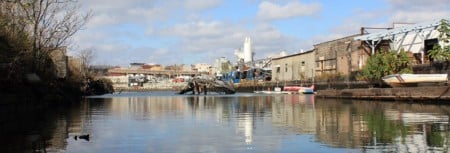
The decision ended a contentious debate and was a blow to the Bloomberg administration, which had proposed a cleanup without such a designation. The city had argued that the label could set off legal battles with polluters, prolong the dredging operation and spook developers leery of the stigma of a Superfund listing.
But in a conference call with reporters, Judith A. Enck, the E.P.A. administrator for the region, said the Superfund designation would guarantee the best result for residents and the environment and ensure that the polluters cover all the costs.
“We believe that it would get us the most efficient and comprehensive cleanup,” Ms. Enck said.
From Gowanus Bay to New York Harbor, the agency has found contamination along the entire length of the clouded 1.8-mile canal in a preliminary assessment, including pesticides, metals and the cancer-causing chemicals known as PCBs.
The agency estimates that the project will last 10 to 12 years and cost $300 million to $500 million. The city estimated that its approach would take nine years.

CONTACT:
Tina Posterli, Riverkeeper, 914-478-4501 x 239
FOR IMMEDIATE RELEASE:
Tarrytown, NY – March 2, 2010 – Riverkeeper, New York’s leading clean water advocate, today commended the Environmental Protection Agency’s decision to list Brooklyn’s toxic Gowanus Canal on the Superfund National Priorities List. The decision to list the canal will begin a comprehensive effort by the federal EPA to remove 150 years of contamination from the Canal’s murky bottom and to address sites along the Canal’s banks that continue to leach pollution into the waterway.
“After 150 years of abuse and neglect the Gowanus Canal will finally get the comprehensive cleanup that the residents of the area deserve,” stated Josh Verleun, Riverkeeper Attorney & Chief Investigator.
“The toxic legacy of coal tar, PCBs, pesticides, and other contamination of the Gowanus can only be cleaned through a comprehensive Superfund cleanup; we are gratified to see the EPA stepping up to this task.”
Riverkeeper has been a vocal advocate for a Superfund cleanup for the Gowanus since the EPA announced that it was considering the Canal for the federal Superfund program in April, 2009. After reviewing an alternative Gowanus cleanup plan put forth by New York City and determining that it was inadequate, Riverkeeper filed comments with the EPA in support of Superfund, joined with community groups to rally support for Superfund from EPA and elected officials, and launched a letter writing campaign in support of the designation.
Riverkeeper’s efforts to support Superfund are part of a larger focus on halting ongoing pollution of the Gowanus Canal. In September, 2009 Riverkeeper launched a pollution enforcement initiative on the Canal filing three Notices of Intent to Sue against environmental law breakers and sent a warning to another. Violations included dumping of scrap metal and debris into the canal; discharge of liquid cement and stone aggregate; and illegal operation of an open dump. Riverkeeper has also increased boat patrols and water quality testing of the Canal and has established partnerships with law enforcement and other agencies to combat ongoing pollution.
http://www.riverkeeper.org/news-events/news/riverkeeper-commends-epa-decision-for-comprehensive-superfund-cleanup-of-toxic-gowanus-canal/


No comments:
Post a Comment